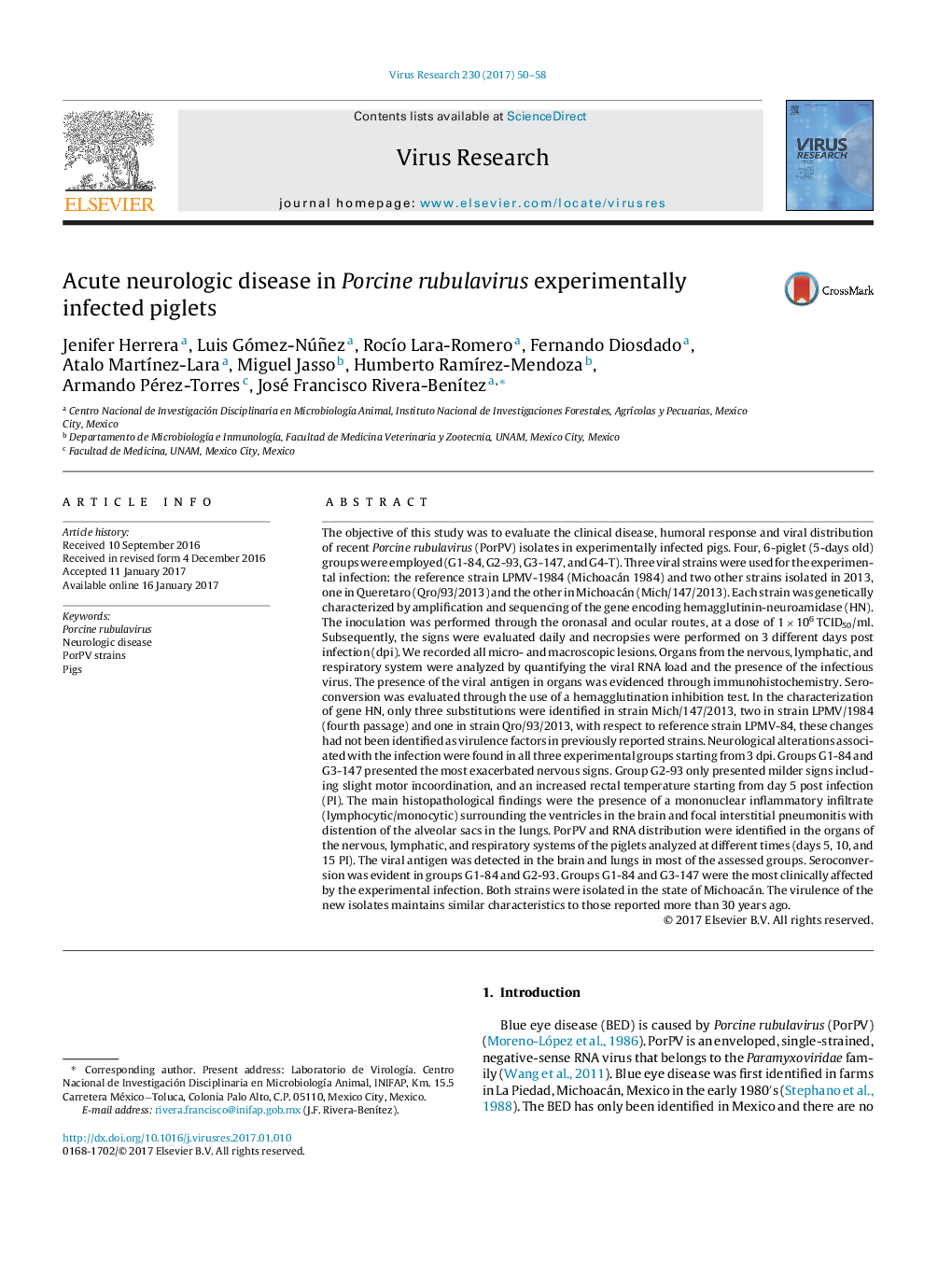| Article ID | Journal | Published Year | Pages | File Type |
|---|---|---|---|---|
| 5675390 | Virus Research | 2017 | 9 Pages |
â¢Experimental infection with recent Porcine rubulavirus strains causes acute neurologic disease in pigs.â¢Viral distribution were identified in nervous, lymphatic, and respiratory systems of the piglets.â¢The neurovirulence of the new isolates maintains similar characteristics to those reported more than 30 years ago.
The objective of this study was to evaluate the clinical disease, humoral response and viral distribution of recent Porcine rubulavirus (PorPV) isolates in experimentally infected pigs. Four, 6-piglet (5-days old) groups were employed (G1-84, G2-93, G3-147, and G4-T). Three viral strains were used for the experimental infection: the reference strain LPMV-1984 (Michoacán 1984) and two other strains isolated in 2013, one in Queretaro (Qro/93/2013) and the other in Michoacán (Mich/147/2013). Each strain was genetically characterized by amplification and sequencing of the gene encoding hemagglutinin-neuroamidase (HN). The inoculation was performed through the oronasal and ocular routes, at a dose of 1Â ÃÂ 106Â TCID50/ml. Subsequently, the signs were evaluated daily and necropsies were performed on 3 different days post infection (dpi). We recorded all micro- and macroscopic lesions. Organs from the nervous, lymphatic, and respiratory system were analyzed by quantifying the viral RNA load and the presence of the infectious virus. The presence of the viral antigen in organs was evidenced through immunohistochemistry. Seroconversion was evaluated through the use of a hemagglutination inhibition test. In the characterization of gene HN, only three substitutions were identified in strain Mich/147/2013, two in strain LPMV/1984 (fourth passage) and one in strain Qro/93/2013, with respect to reference strain LPMV-84, these changes had not been identified as virulence factors in previously reported strains. Neurological alterations associated with the infection were found in all three experimental groups starting from 3Â dpi. Groups G1-84 and G3-147 presented the most exacerbated nervous signs. Group G2-93 only presented milder signs including slight motor incoordination, and an increased rectal temperature starting from day 5 post infection (PI). The main histopathological findings were the presence of a mononuclear inflammatory infiltrate (lymphocytic/monocytic) surrounding the ventricles in the brain and focal interstitial pneumonitis with distention of the alveolar sacs in the lungs. PorPV and RNA distribution were identified in the organs of the nervous, lymphatic, and respiratory systems of the piglets analyzed at different times (days 5, 10, and 15 PI). The viral antigen was detected in the brain and lungs in most of the assessed groups. Seroconversion was evident in groups G1-84 and G2-93. Groups G1-84 and G3-147 were the most clinically affected by the experimental infection. Both strains were isolated in the state of Michoacán. The virulence of the new isolates maintains similar characteristics to those reported more than 30 years ago.
